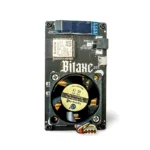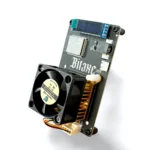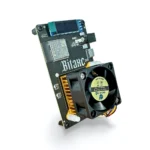Bitaxe Ultra open-source firmware: How to make modifications?
Bitaxe Ultra Open-Source Firmware: How to Make Modifications?
The cryptocurrency mining landscape has evolved significantly over the years, with advancements in hardware and software driving efficiency and accessibility. Among the latest innovations is the Bitaxe Ultra, a compact yet powerful ASIC Bitcoin solo miner that stands out not only for its technical prowess but also for its revolutionary open-source architecture. This article delves into the practical aspects of modifying the Bitaxe Ultra firmware, offering insights and guidance for mining operators and cryptocurrency enthusiasts looking to optimize their mining operations.
Introducing the Bitaxe Ultra: A Game-Changer in Solo Mining
The Bitaxe Ultra is a groundbreaking device in the world of Bitcoin mining. Designed for solo miners, it combines the efficiency of ASIC technology with the flexibility of open-source firmware. At its core lies the proven BM1366 ASIC chip, delivering an impressive 500 GH/s hashrate while consuming just 15 watts of power. This translates to an exceptional performance-to-power ratio of 33.3 GH/s per watt, making it one of the most energy-efficient miners in its class.
What truly sets the Bitaxe Ultra apart is its open-source architecture. As the world’s first open-source ASIC miner, it empowers users to inspect, modify, and enhance the firmware, fostering a community-driven approach to mining hardware development. This transparency not only builds trust but also enables miners to tailor the device to their specific needs, ensuring long-term relevance in an ever-evolving industry.

The Advantages of Open-Source Firmware
Before diving into the specifics of modifying the Bitaxe Ultra firmware, it’s important to understand the benefits of open-source architecture in mining hardware:
- Transparency and Trust: Open-source firmware allows users to verify the code, ensuring there are no hidden backdoors or vulnerabilities. This transparency fosters trust in the device and its operations.
- Customization: Miners can modify the firmware to optimize performance, adapt to changing network conditions, or integrate with other tools and systems.
- Community Collaboration: Open-source projects thrive on community contributions. Users can share improvements, bug fixes, and new features, driving continuous innovation.
- Cost Efficiency: By enabling users to make modifications themselves, open-source firmware reduces reliance on proprietary updates and support, lowering operational costs.
- Decentralization: Open-source tools align with the ethos of decentralization, empowering individual miners to take control of their operations without depending on centralized entities.
With these advantages in mind, let’s explore how to make modifications to the Bitaxe Ultra firmware.
Getting Started with Firmware Modifications
1. Understanding the Architecture
The Bitaxe Ultra is built around the ESP32-S3-WROOM-1 development board, which serves as the microcontroller for the device. This board comes with 16MB of flash storage, providing ample space for firmware and customizations. The open-source nature of the device means that the firmware code is accessible for review and modification.
To begin, familiarize yourself with the Bitaxe Ultra’s GitHub repository, where the firmware and related documentation are hosted. This repository is the central hub for accessing the source code, submitting issues, and contributing to the project.
2. Setting Up the Development Environment
To modify the firmware, you’ll need to set up a development environment on your computer. Here’s a step-by-step guide:

- Install the ESP-IDF Framework: The ESP32-S3-WROOM-1 board uses the Espressif IoT Development Framework (ESP-IDF). Download and install the latest version from the official Espressif website.
- Clone the Bitaxe Ultra Repository: Use Git to clone the Bitaxe Ultra firmware repository to your local machine. This will give you access to the source code and related files.
- Configure Your IDE: Set up an integrated development environment (IDE) such as Visual Studio Code or Eclipse with the necessary extensions for ESP32 development.
- Connect the Bitaxe Ultra: Use a USB cable to connect the Bitaxe Ultra to your computer. Ensure that the device is recognized and communication is established.
3. Exploring the Firmware Code
Once your development environment is ready, it’s time to explore the firmware code. The Bitaxe Ultra firmware is written in C/C++ and is organized into modules that handle various aspects of the mining process, such as:
- Hashrate Optimization: Adjusting algorithms to maximize mining efficiency.
- Network Communication: Managing connections to the Bitcoin network and processing block templates.
- Thermal Management: Controlling fan speed and monitoring temperature to prevent overheating.
Take time to understand how these modules interact and identify areas where modifications could yield improvements.
4. Making Modifications
With a solid understanding of the codebase, you can start making modifications. Here are some practical examples of changes you might consider:
- Enhancing Efficiency: Fine-tune the hashing algorithms to optimize performance based on your specific hardware setup and environmental conditions.
- Custom Cooling Profiles: Modify the thermal management module to create custom cooling profiles that balance performance and energy consumption.
- Network Integration: Integrate the Bitaxe Ultra with other tools or services, such as monitoring dashboards or automated reporting systems.
- Security Enhancements: Add additional layers of security to protect against potential threats or vulnerabilities.
When making changes, it’s essential to test your modifications thoroughly. Use the development environment to simulate mining operations and validate the impact of your updates.
5. Compiling and Flashing the Firmware
After implementing your modifications, compile the firmware using the ESP-IDF tools. This process converts your code into a binary file that can be uploaded to the Bitaxe Ultra.
To flash the updated firmware:

- Connect the Bitaxe Ultra to your computer via USB.
- Use the
idf.py flashcommand to upload the new firmware. - Monitor the process to ensure the update is successful.
6. Contributing to the Community
One of the most significant advantages of open-source projects is the ability to contribute to the community. If your modifications yield improvements, consider sharing them with the broader Bitaxe Ultra community by submitting a pull request to the GitHub repository. This collaborative approach helps drive innovation and ensures the continued evolution of the platform.
Practical Applications of Modified Firmware
Modifying the Bitaxe Ultra firmware opens up a world of possibilities for mining operators. Here are some real-world applications:
- Optimizing for Specific Environments: Tailor the firmware to suit your mining environment, whether it’s a small home setup or a larger-scale operation.
- Integrating with Mining Pools: While the Bitaxe Ultra is designed for solo mining, modifications could enable integration with mining pools if desired.
- Automating Operations: Develop scripts and automation tools to streamline mining operations, reducing manual intervention and improving efficiency.
- Experimenting with New Features: Use the open-source platform to test new ideas and features, contributing to the advancement of mining technology.
Conclusion: Empowering Miners Through Open-Source Innovation
The Bitaxe Ultra represents a significant leap forward in the world of Bitcoin mining, combining cutting-edge ASIC technology with the flexibility of open-source firmware. By enabling users to modify and optimize the firmware, it empowers miners to take control of their operations, adapt to changing conditions, and contribute to the broader mining community.
Whether you’re an experienced miner or a newcomer to the field, the Bitaxe Ultra offers a unique opportunity to engage with Bitcoin mining on a deeper level. Its compact design, exceptional energy efficiency, and open-source architecture make it an ideal choice for those looking to participate meaningfully in the Bitcoin network while exploring the limitless potential of custom firmware modifications.
As the mining landscape continues to evolve, tools like the Bitaxe Ultra will play a crucial role in shaping the future of decentralized cryptocurrency networks. By embracing open-source innovation and leveraging the power of community collaboration, miners can ensure that they remain at the forefront of this dynamic and transformative industry.